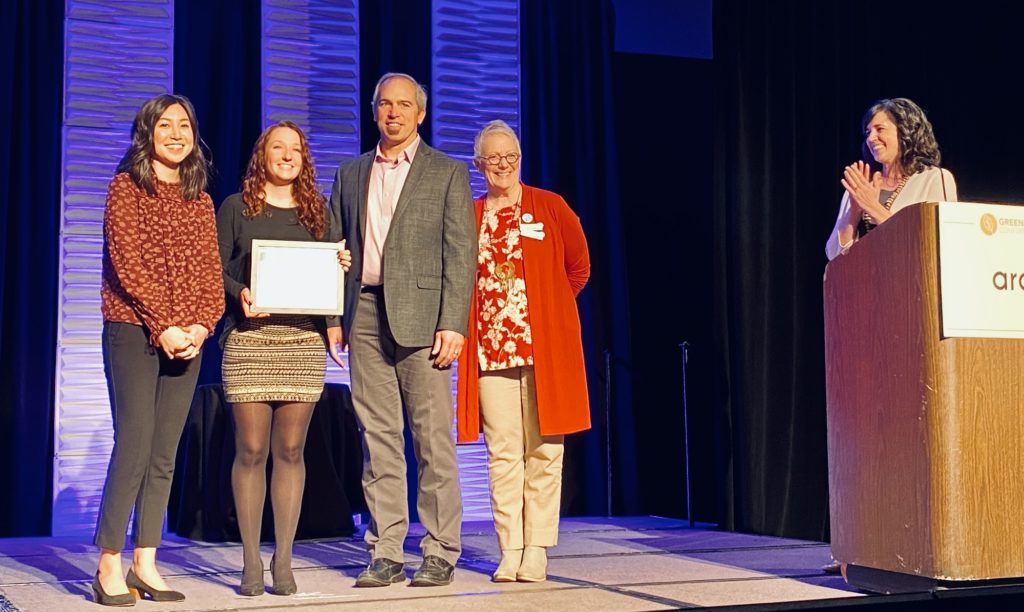 NBI Project Manager Reilly Loveland was recently awarded the USGBC Center for Green Schools Ambassador Award at the March Green Schools Conference and Expo held this year in NBI’s hometown, Portland. Ore. We asked Reilly some questions about the award, what the green schools movement means to her, and how every person can participate in greening our nation’s schools.
NBI Project Manager Reilly Loveland was recently awarded the USGBC Center for Green Schools Ambassador Award at the March Green Schools Conference and Expo held this year in NBI’s hometown, Portland. Ore. We asked Reilly some questions about the award, what the green schools movement means to her, and how every person can participate in greening our nation’s schools.
Q: Congratulations on this award! What do you think it is about the work you’ve done that got you this recognition?
A: I really feel like getting this award reflects all the work that people are doing around me. Most of what I do is to make connections so that people understand that zero energy and high performance schools ARE POSSIBLE BECAUSE THEY EXIST! I really enjoy spending time and listening to people’s stories about what they want to accomplish and what they have accomplished in their schools. My focus is on helping develop their skills and giving them the tools and resources to implement their projects. I think it is those relationships that are recognized with this award.
Q: Why do you think schools represent a key market for your Getting to Zero work?
A: Schools are early adopters and visible models of change that can cultivate and capitalize on students’ enthusiasm for positive change that can set a precedence for the entire community to follow suit. Zero energy schools are living laboratories that can provide hands-on, tangible learning opportunities that tie directly to STEAM education and national education standards like Next Generation Science Standards (NGSS) and Common Core. Students are a ready and capable population to spur change and become leaders – and really, they are already leaders.
Additionally, schools make good zero energy projects because the building form itself is often ideal for low-energy use, the building occupancy and use patterns are generally planned, they have sufficient land for renewables, and are owner controlled and occupied. The benefits of these buildings are backed up by scientific studies showing districts save money that can be put back into the classroom. They have increased student performance with better occupant health, attendance and improved teacher satisfaction/retention.
Q: What are some of the successes in the market that inspire you?
A: Where do I even start? It’s a long list so I’ll just name a few.
-
- All of the student led climate rallies happening not just in our own backyard but all over the world
- Every school that considers going green or zero energy in any aspect – even beyond energy (waste, water, indoor air, gardens, etc.) and that wants to incorporate sustainability or climate into the classroom
- The fact that carbon emissions and zero energy is in the mainstream media (See John Oliver)
- That even though environmental regulations and laws have been under attack – cities, districts and states are working double time to counteract the negative impacts and set their own laws
- Every single smiling student I see at a bond meeting, a facilities master planning meeting (!), and engaging with their school building
Q: What are some of the barriers to achieving market change that worry you?
A: Funding is often an issue with so little provided to schools for capital improvements that passing bonds is the only way to make big and necessary upgrades. I see some negative (and ultimately uninformed) comments about bonds and how school districts are constantly doing things wrong. This in many cases is not true. Educating the public on the importance of bonds and the positive effects of new and modernized schools is necessary. Disinformation worries me the most. Being transparent in bond language and having a long-term plan laying out the improvements and expected outcomes is one way we help solve this issue. Now we just need more states to give funding for capital improvements!
Q: How did you get into this line of work?
A: In college I majored in Geophysics and Environmental Science & Resource Management. I wasn’t really sure where that would lead me, but I liked rocks and dirt and the way the earth is constantly moving. Many people in this field get recruited to work for mining companies or oil companies and I was headed in that direction until I started teaching after school science programs and doing some energy data analysis at the Integrated Design Lab. This led to working at Washington Green Schools, chairing the USGBC-LA Green School Committee and ultimately coming to NBI. I knew I loved how students reacted to science and sustainability. Through green teams and other activities, I saw students develop habits of discovery, problem-solving, teamwork and ultimately the urge for social action. I wanted to do something to give them physical spaces to nurture these skills, tangible learning opportunities to tie it all together, and understand how what they do impacts everyone around them, and ultimately the world. It’s a unique and rewarding field and I can’t wait to see how it continues to grow.
